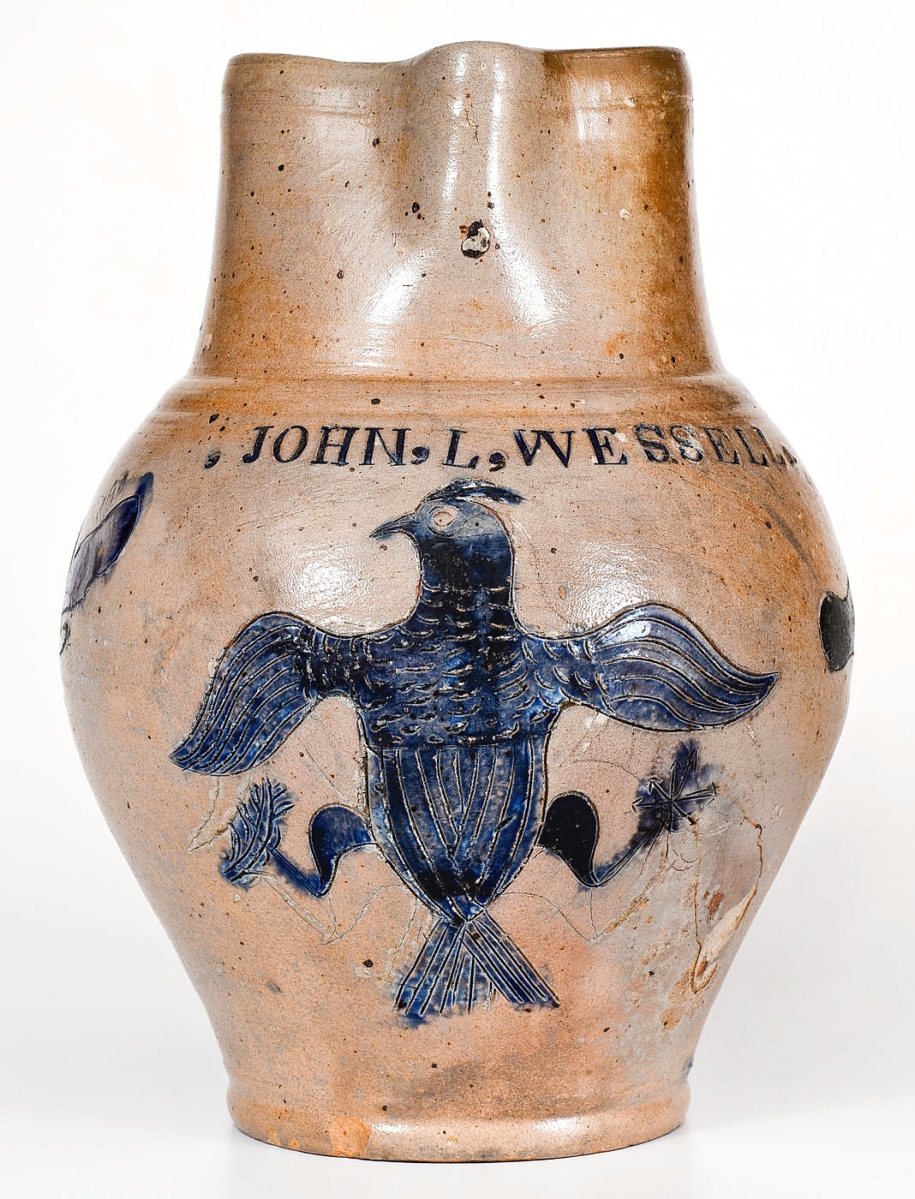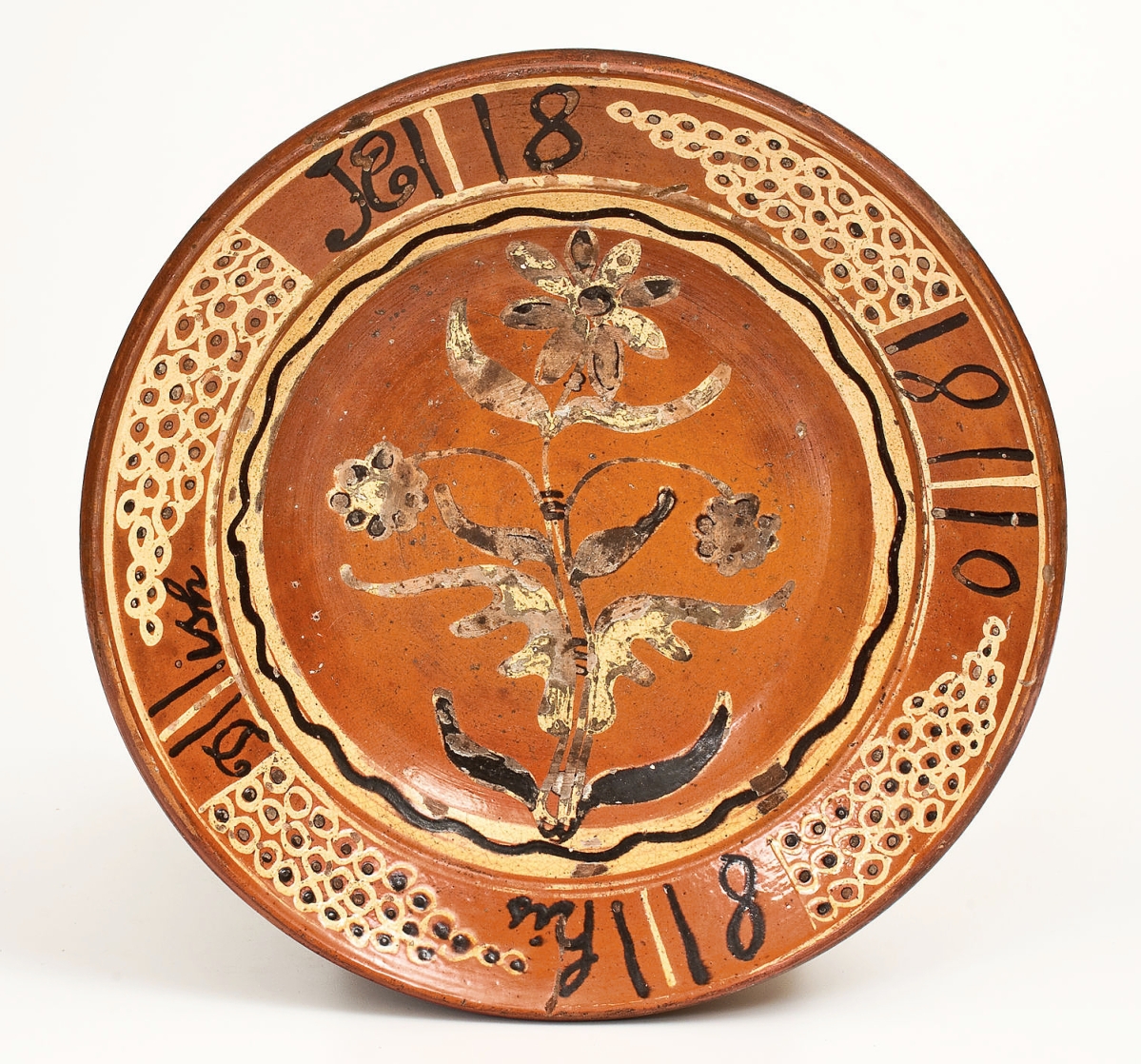
This record-breaking pitcher led the sale and showed one of the earliest eagles to appear on American stoneware; the pitcher surpassed its $80/120,000 estimate to achieve $264,000.
Review by Z.G. Burnett, Photos Courtesy of Crocker Farm
SPARKS, MD. – The Fall 2022 Stoneware & Redware Auction at Crocker Farm closed on November 18, with online and absentee bidding having begun on November 4. The final phone session took place on November 19, with the top four bidders of each lot over $5,000 competing for their preferred piece of crockery. The auction’s total was $1,242,810 with all lots sold and was Crocker Farm’s ninth sale to gross of more than $1 million in a row since the beginning of 2020. “The market has remained consistently strong during that time through all value levels,” said Brandt Zipp, co-owner of the auction house.
The top contributor to this result was a highly important pitcher with an incised Federal eagle decoration that set a world auction record for New York City stoneware at $264,000. Impressed with the cobalt-highlighted name, “John, L, Wessell” and the date “September 15th 1806,” the pitcher showed a spread-winged Federal eagle clutching an olive branch and arrows in its talons, as well as a patriotic shield, similar to the original 1782 design of the Great Seal of the United States. The pitcher’s stylized floral motifs gave it a firm attribution to the Crolius family of potters who were prolific in the area during the turn of the Nineteenth Century. The pitcher belonged to local cabinetmaker John Wessells (here “Wessell”), whose advertisements appear in newspapers beginning in 1800.
Cobalt-decorated avian scenes by New York makers were popular during the sale, including a 5-gallon churn with a “Phoenix Bird” scene, stamped “N. Clark & Co./Rochester N.Y.,” that was the second highest selling lot of the auction at $72,000. Attributed to John Burger, a French-born potter viewed as one of the greatest Nineteenth Century stoneware decorators, the attention taken to the bird’s feathers and anatomy is uncommon in American stoneware. Only a few Rochester-made pieces with this design are known. Another rare bird was found on a 3-gallon stoneware jug decorated with a perched peacock and stamped “White’s Utica” of New York, circa 1865. This motif usually shows a pheasant, but the decoration’s “spotted eye” tail confirmed that it was indeed a peacock. The jug achieved $19,200.
Third in the sale was an extremely rare 5-gallon alkaline-glazed stoneware jug, fresh to the market and signed by African American potter David Drake (1800-1865), that bid to $42,000. Inscribed “Lm/March 31, 1852/Dave,” the high-shouldered ovoid jug with one remaining applied strap handle is one of only a few documented examples made by Drake; this example was created at Lewis Miles’s Stony Bluff Manufactory, Horse Creek Valley, Edgefield District, S.C. The jug descended in the consignor’s family.

Shenandoah Valley redware dish attributed to Peter Bell (active in Hagerstown, Md., and Winchester, Va.), rare for its age and size at 14½ inches in diameter, brought $39,000 ($8/12,000).
Several examples of important and rare redware were offered including the fourth highest lot, a Shenandoah Valley dish attributed to Peter Bell (1775-1847) of Hagerstown, Md., that more than tripled its high estimate to $39,000. Only two of Bell’s creations are stamped with his mark. Inscribed, “JE/his Dish/1808,” the large dish is profusely decorated with “grape cluster” and “fish scale” motifs previously associated with Bell’s work. An example of this age and size is particularly scarce and has a long provenance, including the Shelley Pioneer Americana collection.
Another possibly unique example of stoneware was a monumental cider cooler inscribed “Granger Cider Press/1776,” signed by brothers Wallace and Cornwall Kirkpatrick of Anna, Ill., 1877. The body of the cooler resembles a tree stump, with a hand-thrown lid topped by a hand-sculpted depiction of “Granger” squeezing an apple. The entire cooler shows original hand painting beneath salt glaze and squeezed out $30,000.
Prices quoted with buyer’s premium as reported by the auction house. For information, www.crockerfarm.com or 410-472-2016.












